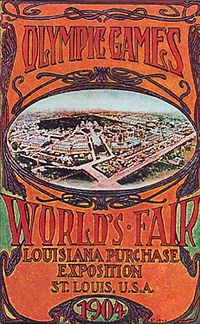
Moments in Olympic Infamy: Anthropology Days
 The first handful of modern Olympic Games would probably look a little strange to fans these days. Things weren’t nearly as slick or organized in the olden days, and never was this more evident than the 1904 St. Louis Games.
The first handful of modern Olympic Games would probably look a little strange to fans these days. Things weren’t nearly as slick or organized in the olden days, and never was this more evident than the 1904 St. Louis Games.
The Third Olympiad was already hamstrung by the fact that many European athletes couldn’t or wouldn’t make the journey to St. Louis, so only 12 nations competed (as opposed to 24 in the 1900 Paris Games). This left the United States free to go apeshit, and they proceeded to win 239 medals; Germany was next with 13.
In fact, St. Louis only got the Games in the first place because they threatened to stage their own sporting competition to upstage Chicago, the city that had originally won them. So St. Louis got the Olympics, but relegated them to a sideshow for the much bigger and more important Louisiana Purchase Exposition (aka World’s Fair).
The Games were marred by a series of problems, not the least of which was the marathon. Athletes ran in brutal heat over dusty roads, and the initial winner (Frederick Lorz) was later found to have gotten a car ride for 11 miles of the race. Thomas Hicks won the race, but was supported across the finish line by his trainers.
But the nadir of the Games occurred on two days when no regular Olympic events were held (August 12/13) — a truly bizarre sideshow called Anthropology Days.
The basic idea of Anthropology Days — the brainchild of Games organizer James E. Sullivan — was to simultaneously showcase a host of “primitive” people from other lands and at the same time prove the superiority of the Anglo-Saxon athlete.
Hmmm, now why does that sound familiar?
Among the “savages” on display during Anthropology Days were Cocopa Indians from Mexico, Ainu from Japan, African pygmies, some Philippine tribes, and Native Americans. How very progressive!
The first day featured standard track and field events such as shot put and 100-yard dash. The participants, never having formally trained in them or even seen them, fared predictably poorly. But the second day was meant to showcase their natural abilities with events like mud fighting, tree climbing, and javelin, the latter being chosen because natives were supposed to be good at throwing spears.

Yup, this really happened.
Based on two days of competition that was farcical at best, Sullivan concluded that “conclusively the savage is not the natural athlete we have been led to believe.”
Somehow I doubt we’ll see any glowing retrospectives about any of this during this year’s Summer Olympics in London.
